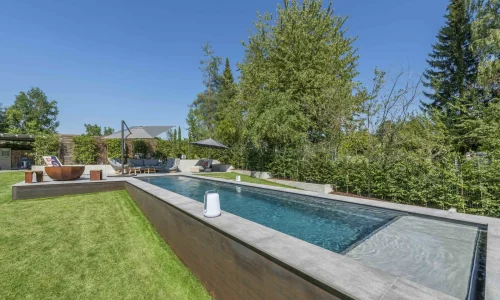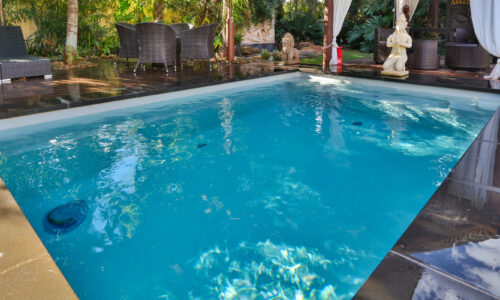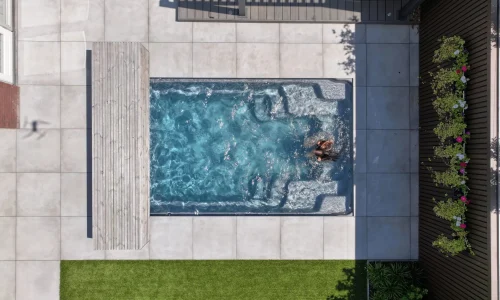
Finding Your Perfect Pool
We offer a wide range of pool types and configurations to create a custom pool that works for your property. In this guide, we’ll walk you through each decision point, helping you understand what matters most before you begin the design process.
Space and Requirements
Measure Your Available Space
Before deciding on the type of pool you want, you need to accurately measure your available space for a successful installation. Start by measuring the total length and width of your potential pool area, remembering that these measurements need to include more than just the pool itself. You’ll need additional space around the pool for decking, landscaping, and access routes for both daily use and maintenance.
Assess the practical aspects of your garden layout too, including existing features like trees, utility lines, or structures like sheds and pergolas that might affect where your pool can go. While a temporary requirement, access routes are particularly important, as installers will require clear paths to reach your chosen location with the necessary equipment like excavation machinery, which typically needs at least 3 metres of clear width.
Finally, how will your pool integrate with your outdoor living spaces? Ensure there’s adequate room for entertaining areas, storage, and the natural flow of movement around your garden.
Lifestyle Considerations
Your pool should reflect how you and your family plan to use the space. A young family with small children has vastly different needs compared to empty nesters looking for relaxation and exercise, or active households focused on entertaining friends and extended family.
Think honestly about your intended usage patterns. Will this primarily be a weekend retreat for relaxation, a daily exercise facility, or the centrepiece of your social entertaining? The frequency and style of use directly influences the ideal size, depth, and features that will serve you best. Additionally, bear pool maintenance in mind, as different designs and features require varying levels of ongoing care.
Pool Types: What are Your Options?
Traditional Swimming Pools
Traditional outdoor swimming pools are the classic choice, with rectangular or geometric designs available that balance recreation, exercise, and entertainment. These pools work well for most garden sizes and provide the greatest flexibility for customisation and future modifications. With predictable maintenance costs and established equipment systems, traditional pools offer reliable, long-term value for households seeking a multipurpose water feature.
Infinity Pools
Infinity pools offer a dramatic visual effect where water appears to flow seamlessly over one or more edges, perfect for properties with scenic views or sloped sites. While they require more complex engineering and higher maintenance costs, this style of pool is elegant, stylish, and provides stunning aesthetics that can transform any garden into a resort-like retreat.
Swim Spas
Swim spas combine exercise and relaxation in a compact format, using powerful jets to create swimming currents in a space much smaller than traditional lap pools. Often featuring dual zones for swimming and spa functions, they’re ideal for properties with limited space and households prioritising fitness and therapy.
Plunge Pools
Plunge pools are perfect for adding luxury to compact spaces. They are designed for cooling off on a hot day and relaxing rather than swimming. Perfect for smaller gardens or as complementary features to outdoor living areas, they heat quickly and economically while requiring minimal maintenance. The smaller scale makes them ideal for urban properties or contemporary landscape designs.
Natural Swimming Pools
Natural swimming pools use biological filtration and aquatic plants instead of chemicals, creating an eco-friendly swimming environment that integrates beautifully with garden landscapes. While requiring different maintenance expertise and higher initial costs, they offer lower operating expenses and environmental benefits that appeal to sustainability-conscious homeowners.
Lap Pools
Lap pools maximise your swimming space in narrower areas. Typically 12+ metres long but only 2-3 metres wide, they are designed specifically for fitness and exercise, and fit into challenging spaces where traditional pools won’t work. Their streamlined design suits contemporary architecture while offering lower heating costs and focused functionality for dedicated swimmers.
Pool Dimensions: Length and Width Selection
Length
Pool length significantly impacts both the swimming experience and the pool’s visual presence in your garden. Compact pools under 6 metres are perfect for smaller gardens where space is at a premium, but still provide excellent opportunities for relaxation, cooling off, and gentle exercise. These sizes work particularly well for families with young children or for those who prioritise lounging and social activities over serious swimming.
Medium-length pools between 6 and 9 metres offer the sweet spot for many of our customers, providing enough space for recreational swimming while remaining manageable in terms of maintenance and heating costs. This length allows for comfortable movement in the water, simple games, and light exercise routines, while still leaving room in most gardens for surrounding landscaping and entertainment areas.
Large pools (anything over 9 metres) are ideal for households serious about swimming and entertaining. These lengths accommodate proper lap swimming, water sports, and larger gatherings. However, they naturally require more garden space and represent a significant commitment in terms of heating, cleaning, and chemical management.
Width
The width of your pool depends on how you balance swimming functionality with available space. Narrower pools are excellent for lane swimming and exercise, providing an efficient use of space while still delivering a genuine swimming experience. These dimensions work particularly well for fitness-focused users or gardens where length is available, but width is constrained.
A more generous width creates a more resort-like feel and can serve as a stunning centrepiece for outdoor entertainment areas. However, they require more space, increase heating and cleaning costs, and may dominate smaller gardens.
Combinations That Work
Certain dimension combinations have proven particularly successful for different household types and garden situations. Compact rectangular designs work beautifully in urban settings or smaller gardens, providing maximum swimming space within minimal footprint.
Larger, more organic shapes create impressive swimming and entertainment spaces but require careful planning to ensure they enhance rather than overwhelm your outdoor environment. Installation complexity can increase with size, particularly regarding excavation, access, and integration with existing landscaping, but the results can be truly spectacular when properly planned.
Step Styles
Step Options
Step styles fundamentally change how you get in and out of your pool, affecting both safety and aesthetics. Traditional corner steps provide a compact entry point that maximises swimming space while offering a clear, defined entry area. These steps typically feature a curved or angled design that integrates smoothly with the pool’s overall shape, creating an elegant transition from deck to water.
Full-width shallow end steps create a beach-like experience, extending across the entire width of the pool’s shallow end. This design provides multiple entry points and creates a spacious area for children to play safely or for adults to relax in shallow water. The wide steps can also serve as additional seating areas.
Entry steps to the side of the pool offer flexibility in placement and design, working particularly well when there are space constraints or landscape features that make traditional steps impractical.
Matching Steps to Usage
Families with young children often benefit most from full-width shallow steps, which provide extensive safe play areas and easy supervision opportunities. The gradual depth transition helps children build confidence naturally, while the wide shallow area accommodates toys, games, and learning activities.
For elderly, vulnerable users or those with mobility considerations, the choice between step styles can significantly impact accessibility and enjoyment. Full-width steps typically offer the easiest and safest entry, with multiple grab points and the ability to enter gradually. The extensive shallow area also provides a comfortable space for water exercise and therapy activities.
Pool Profiles: Depth and Shape Variations
Profile Types Explained
Pool profiles describe the depth variation and bottom shape of your pool, fundamentally affecting how the space can be used. Shallow profiles maintain a consistent, moderate depth throughout most or all of the pool, prioritising safety and accessibility, so they’re ideal for families with young children, non-swimmers, or those who prefer standing-depth water for exercise and relaxation activities.
Deep end profiles feature a distinct deep section, usually 1.8 metres or more, which is connected to shallow areas through a sloped transition. These profiles accommodate diving, advanced swimming techniques, and water sports while still providing shallow areas for general recreation. Finally, as the name suggests, variable depth profiles feature multiple depth zones throughout the pool for greater versatility.
Matching Your Pool Profile to Activities
Different water activities thrive in specific depth profiles, so thinking about how you’ll use your pool is key to choosing the right style for your needs. Water games, volleyball, and social activities often work best in consistent shallow-to-medium depths where all participants can comfortably stand and move freely.
Exercise activities like water aerobics or therapy also benefit from standing-depth water that provides resistance while maintaining safety and comfort. Serious swimmers who want to swim laps or develop a stronger stroke will typically require a consistent, deeper water level that allows for proper technique without interference from the bottom of the pool.
Beyond the Basics
Access to the installation site and ground conditions are both crucial to the feasibility and cost of your pool installation. Your chosen pool needs to be installable given your specific site conditions, including soil type, drainage, and any underground utilities. Steep slopes, rocky ground, or limited access can affect both the installation process and the final cost, making it important to consider these factors early in your selection process.
Planning permission requirements also vary by location and pool type, with some designs potentially requiring formal approval while others may fall under permitted development rights. Larger pools, those in conservation areas, or installations that significantly alter ground levels are more likely to require planning permission. It’s worth checking local requirements early in your decision process to avoid disappointment later.
Long-term Requirements
Maintenance varies significantly between different pool types and features, affecting both your ongoing time commitment and costs. A saltwater pool will have different demands compared to a natural pool or a classic chlorine pool, so think about how much maintenance you’re willing to commit to or factor professional maintenance services into your budget.
The potential for future modifications or additions might also influence your initial design choice, particularly if you anticipate changing needs over time. Some pool designs more easily accommodate additions like spas, water features, or heating systems, while others are more fixed in their configuration.
Start Designing Your Perfect Pool
At Compass Pools, we understand that every home, garden and lifestyle is unique. That’s why we’ve developed our pool finder system to help you navigate through our extensive pool collection to find the designs that perfectly match your specific requirements. Rather than browsing through countless configurations, you can quickly narrow down to a curated selection of pools that are genuinely suitable for your situation.
The next step involves booking a consultation with our pool experts who can provide personalised guidance based on your specific situation and preferences. During this consultation, you can discuss how your shortlisted designs would work in your garden, explore customisation options, and get accurate pricing and timeline information for your project. Contact Compass Pools today to find out more.
Written By: Alex Kemsley































